
MOOSE
MOOSE (Multi-organ objective segmentation) a data-centric AI solution that generates multilabel organ segmentations to facilitate systemic TB whole-person research.The pipeline is based on nn-UNet and has the capability to segment 120 unique tissue classes from a whole-body 18F-FDG PET/CT image.
Stars: 182
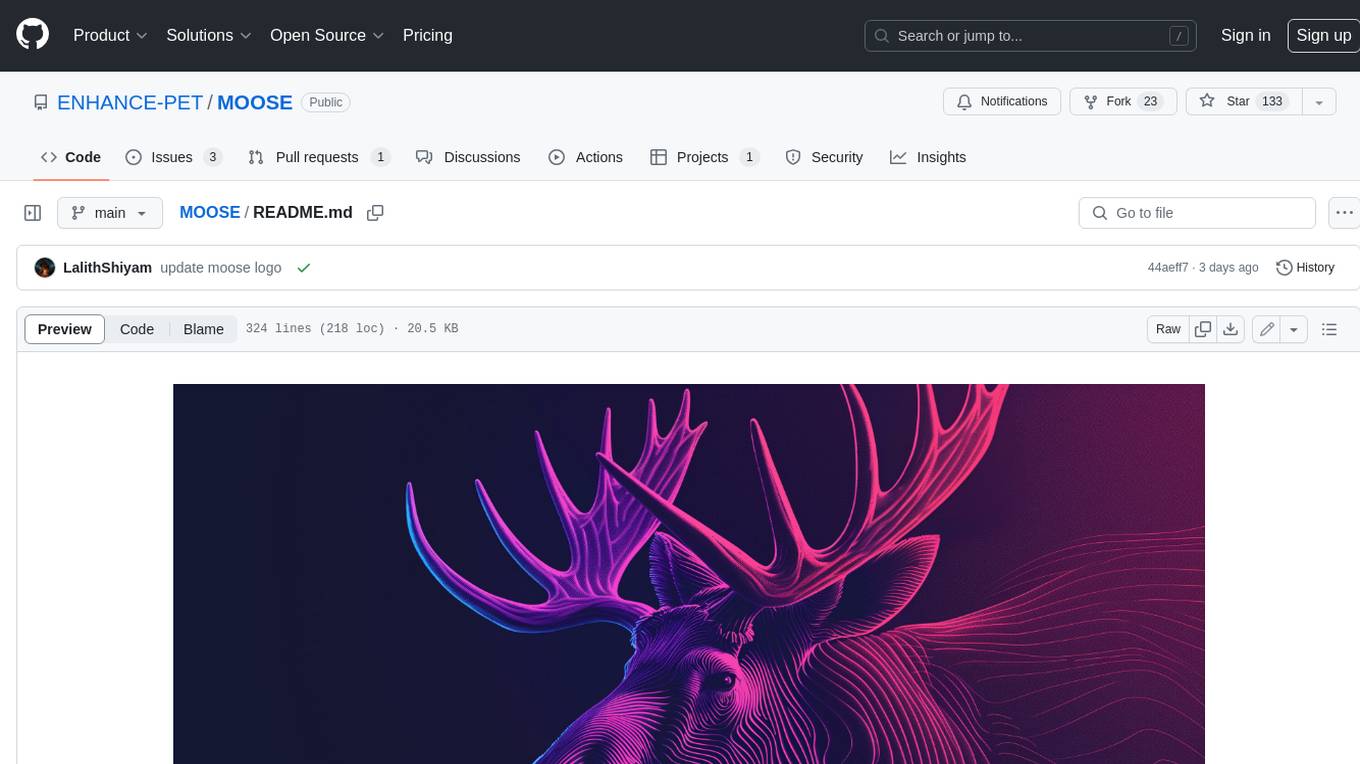
MOOSE 2.0 is a leaner, meaner, and stronger tool for 3D medical image segmentation. It is built on the principles of data-centric AI and offers a wide range of segmentation models for both clinical and preclinical settings. MOOSE 2.0 is also versatile, allowing users to use it as a command-line tool for batch processing or as a library package for individual processing in Python projects. With its improved speed, accuracy, and flexibility, MOOSE 2.0 is the go-to tool for segmentation tasks.
README:
Welcome to the new and improved MOOSE (v3.0), where speed and efficiency aren't just buzzwords—they're a way of life.
💨 3x Faster Than Before
Like a moose sprinting through the woods (okay, maybe not that fast), MOOSE 3.0 is built for speed. It's 3x faster than its older sibling, MOOSE 2.0, which was already no slouch. Blink and you'll miss it. ⚡
💻 Memory: Light as a Feather, Strong as a Bull
Forget "Does it fit on my laptop?" The answer is YES. 🕺 Thanks to Dask wizardry, all that data stays in memory. No disk writes, no fuss. Run total-body CT on that 'decent' laptop you bought three years ago and feel like you’ve upgraded. 🥳
🛠️ Any OS, Anytime, Anywhere
Windows, Mac, Linux—we don’t play favorites. 🍏 Mac users, you’re in luck: MOOSE runs natively on MPS, getting you GPU-like speeds without the NVIDIA guilt. 🚀
🎯 Trained to Perfection
This is our best model yet, trained on a whopping 1.7k datasets. More data, better results. Plus you can run multiple models at the same time - You'll be slicing through images like a knife through warm butter. (Or tofu, if you prefer.) 🧈🔪
🖥️ The 'Herd' Mode 🖥️
Got a powerhouse server just sitting around? Time to let the herd loose! Flip the Herd Mode switch and watch MOOSE multiply across your compute like... well, like a herd of moose! 🦌🦌🦌 The more hardware you have, the faster your inference gets done. Scale up, speed up, and make every bit of your server earn its oats. 🌾💨
MOOSE 3.0 isn't just an upgrade—it's a lifestyle. A faster, leaner, and stronger lifestyle. Ready to join the herd? 🦌✨
MOOSE 3.0 offers a wide range of segmentation models catering to various clinical and preclinical needs. Here are the models currently available:
| Model Name | Intensities and Regions |
|---|---|
clin_ct_body |
1:Legs, 2:Body, 3:Head, 4:Arms |
clin_ct_cardiac |
1:heart_myocardium, 2:heart_atrium_left, 3:heart_ventricle_left, 4:heart_atrium_right, 5:heart_ventricle_right, 6:pulmonary_artery, 7:iliac_artery_left, 8:iliac_artery_right, 9:iliac_vena_left, 10:iliac_vena_right |
clin_ct_digestive |
1:esophagus, 2:trachea, 3:small_bowel, 4:duodenum, 5:colon, 6:urinary_bladder, 7:face |
clin_ct_fat |
1:spinal_chord, 2:skeletal_muscle, 3:subcutaneous_fat, 4:visceral_fat, 5:thoracic_fat, 6:eyes, 7:testicles, 8:prostate |
clin_ct_lungs |
1:lung_upper_lobe_left, 2:lung_lower_lobe_left, 3:lung_upper_lobe_right, 4:lung_middle_lobe_right, 5:lung_lower_lobe_right |
clin_ct_muscles |
1:gluteus_maximus_left, 2:gluteus_maximus_right, 3:gluteus_medius_left, 4:gluteus_medius_right, 5:gluteus_minimus_left, 6:gluteus_minimus_right, 7:autochthon_left, 8:autochthon_right, 9:iliopsoas_left, 10:iliopsoas_right |
clin_ct_organs |
1:spleen, 2:kidney_right, 3:kidney_left, 4:gallbladder, 5:liver, 6:stomach, 7:aorta, 8:inferior_vena_cava, 9:portal_vein_and_splenic_vein, 10:pancreas, 11:adrenal_gland_right, 12:adrenal_gland_left, 13:lung_upper_lobe_left, 14:lung_lower_lobe_left, 15:lung_upper_lobe_right, 16:lung_middle_lobe_right, 17:lung_lower_lobe_right |
clin_ct_peripheral_bones |
1:carpal_left, 2:carpal_right, 3:clavicle_left, 4:clavicle_right, 5:femur_left, 6:femur_right, 7:fibula_left, 8:fibula_right, 9:humerus_left, 10:humerus_right, 11:metacarpal_left, 12:metacarpal_right, 13:metatarsal_left, 14:metatarsal_right, 15:patella_left, 16:patella_right, 17:fingers_left, 18:fingers_right, 19:radius_left, 20:radius_right, 21:scapula_left, 22:scapula_right, 23:skull, 24:tarsal_left, 25:tarsal_right, 26:tibia_left, 27:tibia_right, 28:toes_left, 29:toes_right, 30:ulna_left, 31:ulna_right, 32:thyroid_left, 33:thyroid_right, 34:bladder |
clin_ct_ribs |
1:rib_left_1, 2:rib_left_2, 3:rib_left_3, 4:rib_left_4, 5:rib_left_5, 6:rib_left_6, 7:rib_left_7, 8:rib_left_8, 9:rib_left_9, 10:rib_left_10, 11:rib_left_11, 12:rib_left_12, 13:rib_right_1, 14:rib_right_2, 15:rib_right_3, 16:rib_right_4, 17:rib_right_5, 18:rib_right_6, 19:rib_right_7, 20:rib_right_8, 21:rib_right_9, 22:rib_right_10, 23:rib_right_11, 24:rib_right_12, 25:sternum |
clin_ct_vertebrae |
1:vertebra_C1, 2:vertebra_C2, 3:vertebra_C3, 4:vertebra_C4, 5:vertebra_C5, 6:vertebra_C6, 7:vertebra_C7, 8:vertebra_T1, 9:vertebra_T2, 10:vertebra_T3, 11:vertebra_T4, 12:vertebra_T5, 13:vertebra_T6, 14:vertebra_T7, 15:vertebra_T8, 16:vertebra_T9, 17:vertebra_T10, 18:vertebra_T11, 19:vertebra_T12, 20:vertebra_L1, 21:vertebra_L2, 22:vertebra_L3, 23:vertebra_L4, 24:vertebra_L5, 25:vertebra_S1, 26:hip_left, 27:hip_right, 28:sacrum |
| Model Name | Intensities and Regions |
|---|---|
preclin_ct_legs |
1:right_leg_muscle, 2:left_leg_muscle |
preclin_mr_all |
1:Brain, 2:Liver, 3:Intestines, 4:Pancreas, 5:Thyroid, 6:Spleen, 7:Bladder, 8:OuterKidney, 9:InnerKidney, 10:HeartInside, 11:HeartOutside, 12:WAT Subcutaneous, 13:WAT Visceral, 14:BAT, 15:Muscle TF, 16:Muscle TB, 17:Muscle BB, 18:Muscle BF, 19:Aorta, 20:Lung, 21:Stomach |
Each model is designed to provide high-quality segmentation with MOOSE 3.0's optimized algorithms and data-centric AI principles.
- Shiyam Sundar, L. K., Yu, J., Muzik, O., Kulterer, O., Fueger, B. J., Kifjak, D., Nakuz, T., Shin, H. M., Sima, A. K., Kitzmantl, D., Badawi, R. D., Nardo, L., Cherry, S. R., Spencer, B. A., Hacker, M., & Beyer, T. (2022). Fully-automated, semantic segmentation of whole-body 18F-FDG PET/CT images based on data-centric artificial intelligence. Journal of Nuclear Medicine. https://doi.org/10.2967/jnumed.122.264063
- Isensee, F., Jaeger, P.F., Kohl, S.A.A. et al. nnU-Net: a self-configuring method for deep learning-based biomedical image segmentation. Nat Methods 18, 203–211 (2021). https://doi.org/10.1038/s41592-020-01008-z
Before you dive into the incredible world of MOOSE 3.0, here are a few things you need to ensure for an optimal experience:
-
Operating System: We've got you covered whether you're on Windows, Mac, or Linux. MOOSE 3.0 has been tested across these platforms to ensure seamless operation.
-
Memory: MOOSE 3.0 has quite an appetite! Make sure you have at least 16GB of RAM for the smooth running of all tasks.
-
GPU: If speed is your game, an NVIDIA GPU is the name! MOOSE 3.0 leverages GPU acceleration to deliver results fast. Don't worry if you don't have one, though - it will still work, just at a slower pace.
-
Python: Ensure that you have Python 3.10 installed on your system. MOOSE 3.0 likes to keep up with the latest, after all!
So, that's it! Make sure you're geared up with these specifications, and you're all set to explore everything MOOSE 3.0 has to offer. 🚀🌐
Available on Windows, Linux, and MacOS, the installation is as simple as it gets. Follow our step-by-step guide below and set sail on your journey with MOOSE 3.0.
-
First, create a Python environment. You can name it to your liking; for example, 'moose-env'.
python3.10 -m venv moose-env
-
Activate your newly created environment.
source moose-env/bin/activate # for Linux
-
Install MOOSE 3.0.
pip install moosez
Voila! You're all set to explore with MOOSE 3.0.
-
First, create a Python environment. You can name it to your liking; for example, 'moose-env'.
python3.10 -m venv moose-env
-
Activate your newly created environment.
source moose-env/bin/activate -
Install MOOSE 3.0 and a special fork of PyTorch (MPS specific). You need to install the MPS specific branch for making MOOSE work with MPS
pip install moosez pip install git+https://github.com/LalithShiyam/pytorch-mps.git
Now you are ready to use MOOSE on Apple Silicon 🏎⚡️.
-
Create a Python environment. You could name it 'moose-env', or as you wish.
python3.10 -m venv moose-env
-
Activate your newly created environment.
.\moose-env\Scripts\activate
-
Go to the PyTorch website and install the appropriate PyTorch version for your system. !DO NOT SKIP THIS!
-
Finally, install MOOSE 3.0.
pip install moosez
There you have it! You're ready to venture into the world of 3D medical image segmentation with MOOSE 3.0.
Happy exploring! 🚀🔬
Getting started with MOOSE 3.0 is as easy as slicing through butter 🧈🔪. Use the command-line tool to process multiple segmentation models in sequence or in parallel, making your workflow a breeze. 🌬️
You can now run single or several models in sequence with a single command. Just provide the path to your subject images and list the segmentation models you wish to apply:
# For single model inference
moosez -d <path_to_image_dir> -m <model_name>
# For multiple model inference
moosez -d <path_to_image_dir> \
-m <model_name1> \
<model_name2> \
<model_name3> \For instance, to run clinical CT organ segmentation on a directory of images, you can use the following command:
moosez -d <path_to_image_dir> -m clin_ct_organsLikewise, to run multiple models e.g. organs, ribs, and vertebrae, you can use the following command:
moosez -d <path_to_image_dir> \
-m clin_ct_organs \
clin_ct_ribs \
clin_ct_vertebraeMOOSE 3.0 will handle each model one after the other—no fuss, no hassle. 🙌✨
Got a powerful server or HPC? Let the herd roam! 🦌🚀 Use Herd Mode to run multiple MOOSE instances in parallel. Just add the -herd flag with the number of instances you wish to run simultaneously:
moosez -d <path_to_image_dir> \
-m clin_ct_organs \
clin_ct_ribs \
clin_ct_vertebrae \
-herd 2MOOSE will run two instances at the same time, utilizing your compute power like a true multitasking pro. 💪👨💻👩💻
And that's it! MOOSE 3.0 lets you process with ease and speed. ⚡✨
Need assistance along the way? Don't worry, we've got you covered. Simply type:
moosez -hThis command will provide you with all the help and the information about the available models and the regions it segments.
MOOSE 3.0 isn't just a command-line powerhouse; it’s also a flexible library for Python projects. Here’s how to make the most of it:
First, import the moose function from the moosez package in your Python script:
from moosez import mooseThe moose function is versatile and accepts various input types. It takes four main arguments:
-
input: The data to process, which can be:- A path to an input file or directory (NIfTI, either
.niior.nii.gz). - A tuple containing a NumPy array and its spacing (e.g.,
numpy_array,(spacing_x, spacing_y, spacing_z)). - A
SimpleITKimage object.
- A path to an input file or directory (NIfTI, either
-
model_names: A single model name or a list of model names for segmentation. -
output_dir: The directory where the results will be saved. -
accelerator: The type of accelerator to use ("cpu","cuda", or"mps"for Mac).
Here are some examples to illustrate different ways to use the moose function:
-
Using a file path and multiple models:
moose('/path/to/input/file', ['clin_ct_organs', 'clin_ct_ribs'], '/path/to/save/output', 'cuda')
-
Using a NumPy array with spacing:
moose((numpy_array, (1.5, 1.5, 1.5)), 'clin_ct_organs', '/path/to/save/output', 'cuda')
-
Using a SimpleITK image:
moose(simple_itk_image, 'clin_ct_organs', '/path/to/save/output', 'cuda')
That's it! With these flexible inputs, you can use MOOSE 3.0 to fit your workflow perfectly—whether you’re processing a single image, a stack of files, or leveraging different data formats. 🖥️🎉
Happy segmenting with MOOSE 3.0! 🦌💫
Using MOOSE 3.0 optimally requires your data to be structured according to specific conventions. MOOSE 3.0 supports both DICOM and NIFTI formats. For DICOM files, MOOSE infers the modality from the DICOM tags and checks if the given modality is suitable for the chosen segmentation model. However, for NIFTI files, users need to ensure that the files are named with the correct modality as a suffix.
Please structure your dataset as follows:
MOOSEv2_data/ 📁
├── S1 📂
│ ├── AC-CT 📂
│ │ ├── WBACCTiDose2_2001_CT001.dcm 📄
│ │ ├── WBACCTiDose2_2001_CT002.dcm 📄
│ │ ├── ... 🗂️
│ │ └── WBACCTiDose2_2001_CT532.dcm 📄
│ └── AC-PT 📂
│ ├── DetailWB_CTACWBPT001_PT001.dcm 📄
│ ├── DetailWB_CTACWBPT001_PT002.dcm 📄
│ ├── ... 🗂️
│ └── DetailWB_CTACWBPT001_PT532.dcm 📄
├── S2 📂
│ └── CT_S2.nii 📄
├── S3 📂
│ └── CT_S3.nii 📄
├── S4 📂
│ └── S4_ULD_FDG_60m_Dynamic_Patlak_HeadNeckThoAbd_20211025075852_2.nii 📄
└── S5 📂
└── CT_S5.nii 📄
Note: If the necessary naming conventions are not followed, MOOSE 3.0 will skip the subjects.
When using NIFTI files, you should name the file with the appropriate modality as a suffix.
For instance, if you have chosen the model_name as clin_ct_organs, the CT scan for subject 'S2' in NIFTI format, should have the modality tag 'CT_' attached to the file name, e.g. CT_S2.nii. In the directory shown above, every subject will be processed by moosez except S4.
Remember: Adhering to these file naming and directory structure conventions ensures smooth and efficient processing with MOOSE 3.0. Happy segmenting! 🚀
Want to power-up your medical image segmentation tasks? ⚡ Join the MooseZ community and contribute your own nnUNetv2 models! 🥇:
By adding your custom models to MooseZ, you can enjoy:
- ⏩ Increased Speed - MooseZ is optimized for fast performance. Use it to get your results faster!
- 💾 Reduced Memory - MooseZ is designed to be efficient and lean, so it uses less memory!
So why wait? Make your models fly with MooseZ
-
Prepare Your Model 📁
Train your model using
nnUNetv2and get it ready for the big leagues! -
Update AVAILABLE_MODELS List ✏️
Include your model's unique identifier to the
AVAILABLE_MODELSlist in the resources.py file. The model name should follow a specific syntax: 'clin' or 'preclin' (indicating Clinical or Preclinical), modality tag (like 'ct', 'pt', 'mr'), and then the tissue of interest. -
Update MODELS Dictionary 📋
Add a new entry to the
MODELSdictionary in the resources.py file. Fill in the corresponding details (like URL, filename, directory, trainer type, voxel spacing, and multilabel prefix). -
Update expected_modality Function 📝
Update the
expected_modalityfunction in the resources.py file to return the imaging technique, modality, and tissue of interest for your model. -
Update map_model_name_to_task_number Function 🗺️
Modify the
map_model_name_to_task_numberfunction in the resources.py file to return the task number associated with your model. -
Update
ORGAN_INDICESinconstants.py🧠Append the
ORGAN_INDICESdictionary in the constants.py with your label intensity to region mapping. This is particularly important if you would like to have your stats from the PET images based on your CT masks.
That's it! You've successfully contributed your own model to the MooseZ community! 🎊
With your contribution 🙋, MooseZ becomes a stronger and more robust tool for medical image segmentation! 💪
All of our Python packages here at QIMP carry a special signature – a distinctive 'Z' at the end of their names. The 'Z' is more than just a letter to us; it's a symbol of our forward-thinking approach and commitment to continuous innovation.
Our MOOSE package, for example, is named as 'moosez', pronounced "moose-see". So, why 'Z'?
Well, in the world of mathematics and science, 'Z' often represents the unknown, the variable that's yet to be discovered, or the final destination in a series. We at QIMP believe in always pushing boundaries, venturing into uncharted territories, and staying on the cutting edge of technology. The 'Z' embodies this philosophy. It represents our constant quest to uncover what lies beyond the known, to explore the undiscovered, and to bring you the future of medical imaging.
Each time you see a 'Z' in one of our package names, be reminded of the spirit of exploration and discovery that drives our work. With QIMP, you're not just installing a package; you're joining us on a journey to the frontiers of medical image processing. Here's to exploring the 'Z' dimension together! 🚀
🦌 MOOSE: A part of the enhance.pet community
</tr>
 Lalith Kumar Shiyam Sundar 💻 📖 |
 Sebastian Gutschmayer 💻 |
n7k-dobri 💻 |
Manuel Pires 💻 |
Zach Chalampalakis 💻 |
David Haberl 💻 |
W7ebere 📖 |
|
Kazezaka 💻 |
Loic Tetrel @ Kitware 💻 📖 |
For Tasks:
Click tags to check more tools for each tasksFor Jobs:
Alternative AI tools for MOOSE
Similar Open Source Tools

MOOSE
MOOSE 2.0 is a leaner, meaner, and stronger tool for 3D medical image segmentation. It is built on the principles of data-centric AI and offers a wide range of segmentation models for both clinical and preclinical settings. MOOSE 2.0 is also versatile, allowing users to use it as a command-line tool for batch processing or as a library package for individual processing in Python projects. With its improved speed, accuracy, and flexibility, MOOSE 2.0 is the go-to tool for segmentation tasks.
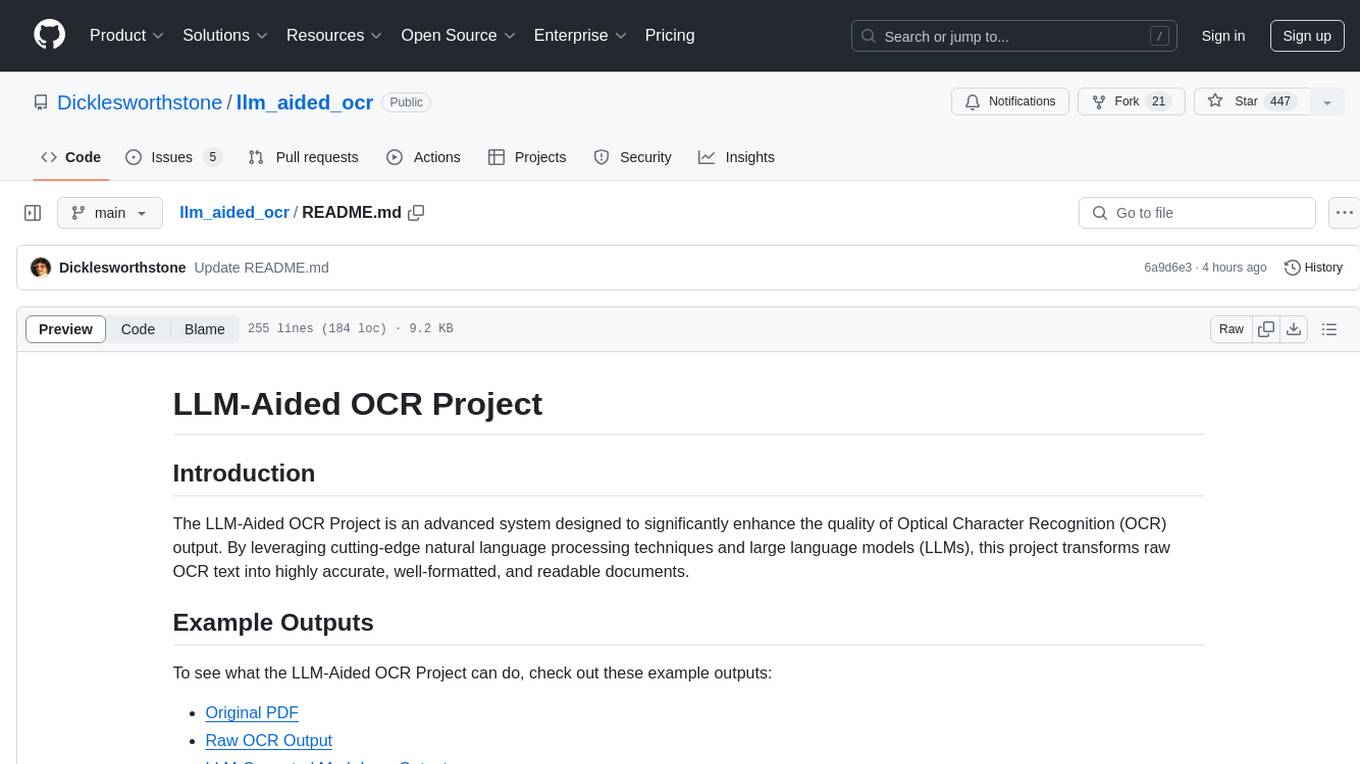
llm_aided_ocr
The LLM-Aided OCR Project is an advanced system that enhances Optical Character Recognition (OCR) output by leveraging natural language processing techniques and large language models. It offers features like PDF to image conversion, OCR using Tesseract, error correction using LLMs, smart text chunking, markdown formatting, duplicate content removal, quality assessment, support for local and cloud-based LLMs, asynchronous processing, detailed logging, and GPU acceleration. The project provides detailed technical overview, text processing pipeline, LLM integration, token management, quality assessment, logging, configuration, and customization. It requires Python 3.12+, Tesseract OCR engine, PDF2Image library, PyTesseract, and optional OpenAI or Anthropic API support for cloud-based LLMs. The installation process involves setting up the project, installing dependencies, and configuring environment variables. Users can place a PDF file in the project directory, update input file path, and run the script to generate post-processed text. The project optimizes processing with concurrent processing, context preservation, and adaptive token management. Configuration settings include choosing between local or API-based LLMs, selecting API provider, specifying models, and setting context size for local LLMs. Output files include raw OCR output and LLM-corrected text. Limitations include performance dependency on LLM quality and time-consuming processing for large documents.
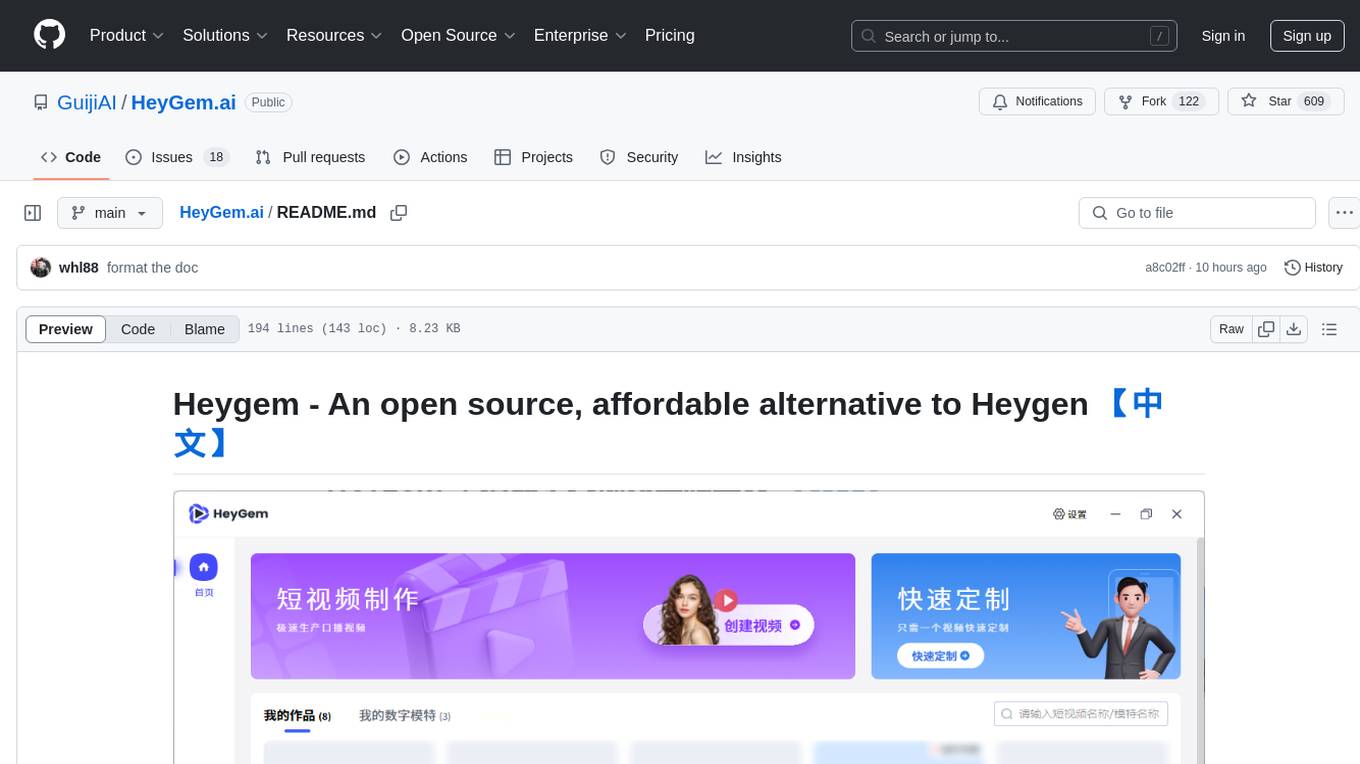
HeyGem.ai
Heygem is an open-source, affordable alternative to Heygen, offering a fully offline video synthesis tool for Windows systems. It enables precise appearance and voice cloning, allowing users to digitalize their image and drive virtual avatars through text and voice for video production. With core features like efficient video synthesis and multi-language support, Heygem ensures a user-friendly experience with fully offline operation and support for multiple models. The tool leverages advanced AI algorithms for voice cloning, automatic speech recognition, and computer vision technology to enhance the virtual avatar's performance and synchronization.
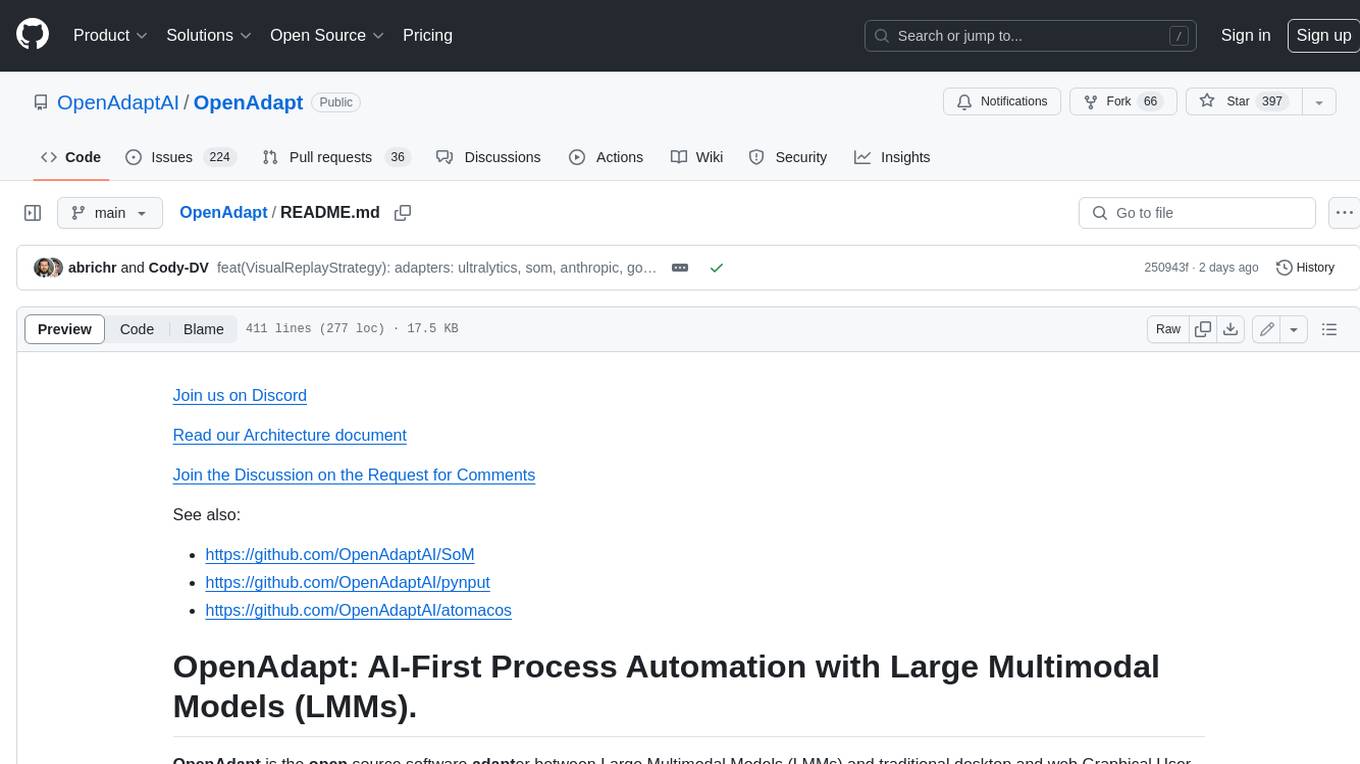
OpenAdapt
OpenAdapt is an open-source software adapter between Large Multimodal Models (LMMs) and traditional desktop and web Graphical User Interfaces (GUIs). It aims to automate repetitive GUI workflows by leveraging the power of LMMs. OpenAdapt records user input and screenshots, converts them into tokenized format, and generates synthetic input via transformer model completions. It also analyzes recordings to generate task trees and replay synthetic input to complete tasks. OpenAdapt is model agnostic and generates prompts automatically by learning from human demonstration, ensuring that agents are grounded in existing processes and mitigating hallucinations. It works with all types of desktop GUIs, including virtualized and web, and is open source under the MIT license.
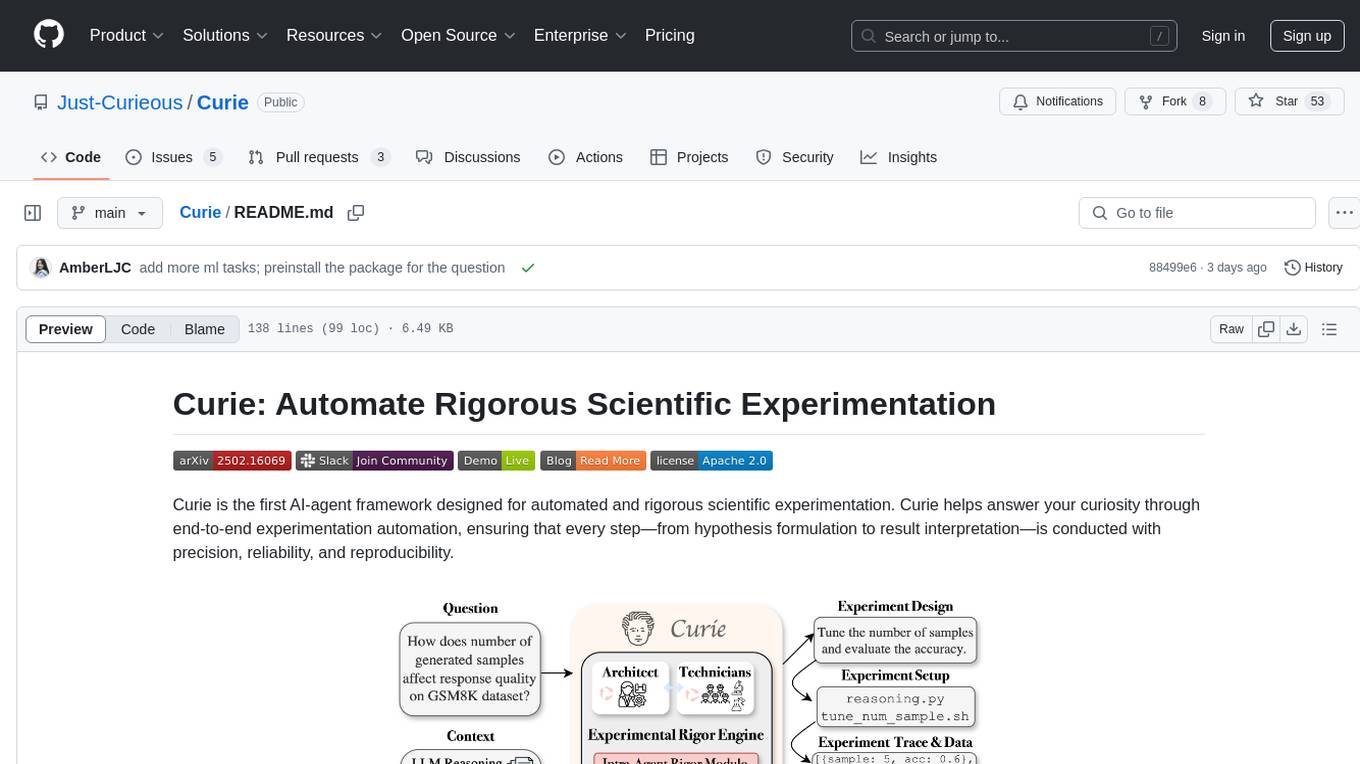
Curie
Curie is an AI-agent framework designed for automated and rigorous scientific experimentation. It automates end-to-end workflow management, ensures methodical procedure, reliability, and interpretability, and supports ML research, system analysis, and scientific discovery. It provides a benchmark with questions from 4 Computer Science domains. Users can customize experiment agents and adapt to their own tasks by configuring base_config.json. Curie is suitable for hyperparameter tuning, algorithm behavior analysis, system performance benchmarking, and automating computational simulations.
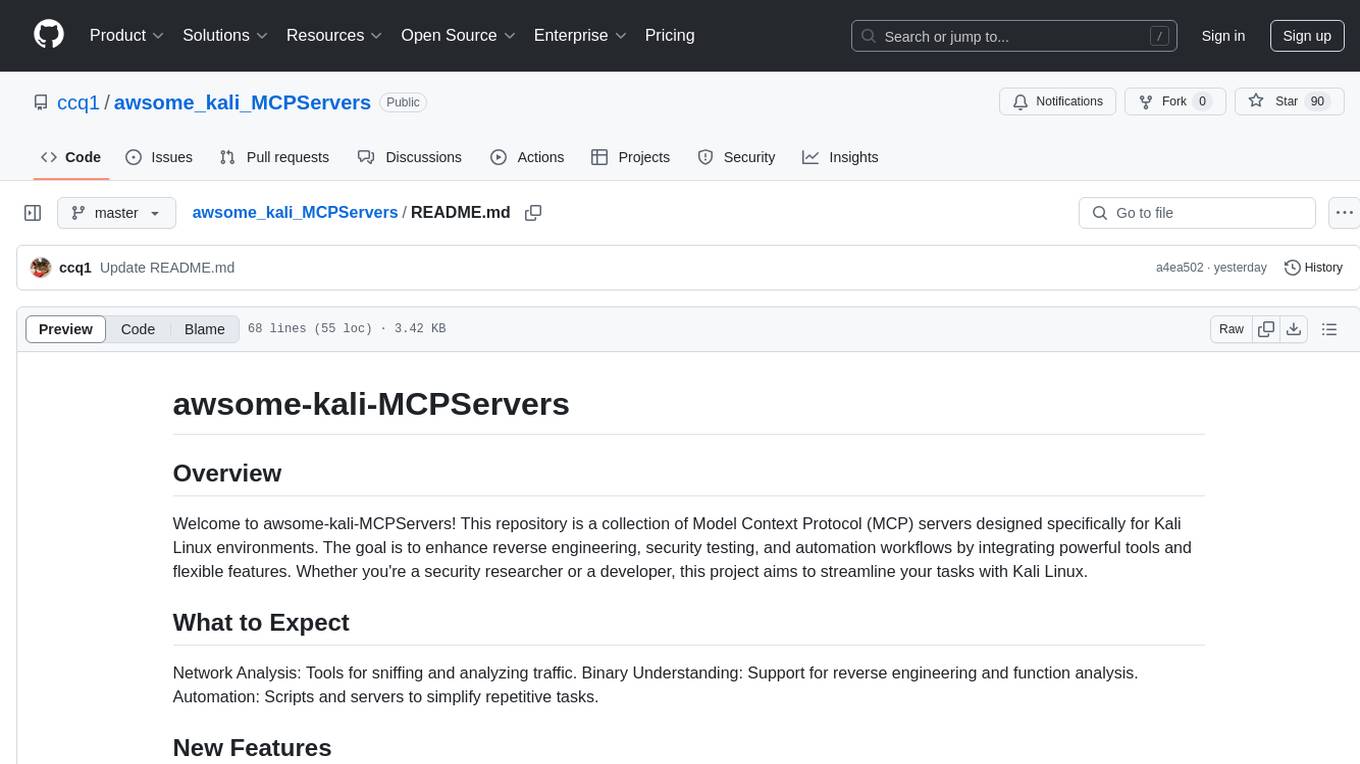
awsome_kali_MCPServers
awsome-kali-MCPServers is a repository containing Model Context Protocol (MCP) servers tailored for Kali Linux environments. It aims to optimize reverse engineering, security testing, and automation tasks by incorporating powerful tools and flexible features. The collection includes network analysis tools, support for binary understanding, and automation scripts to streamline repetitive tasks. The repository is continuously evolving with new features and integrations based on the FastMCP framework, such as network scanning, symbol analysis, binary analysis, string extraction, network traffic analysis, and sandbox support using Docker containers.
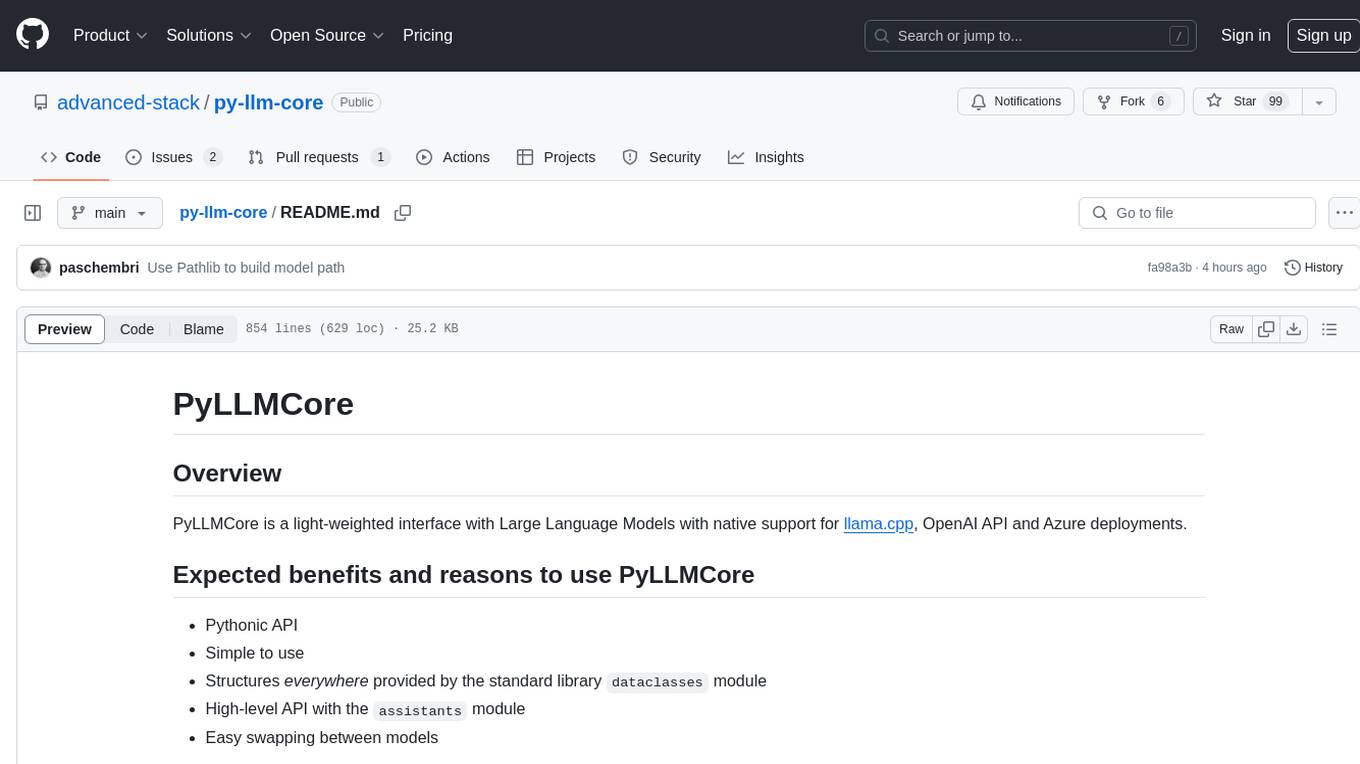
py-llm-core
PyLLMCore is a light-weighted interface with Large Language Models with native support for llama.cpp, OpenAI API, and Azure deployments. It offers a Pythonic API that is simple to use, with structures provided by the standard library dataclasses module. The high-level API includes the assistants module for easy swapping between models. PyLLMCore supports various models including those compatible with llama.cpp, OpenAI, and Azure APIs. It covers use cases such as parsing, summarizing, question answering, hallucinations reduction, context size management, and tokenizing. The tool allows users to interact with language models for tasks like parsing text, summarizing content, answering questions, reducing hallucinations, managing context size, and tokenizing text.
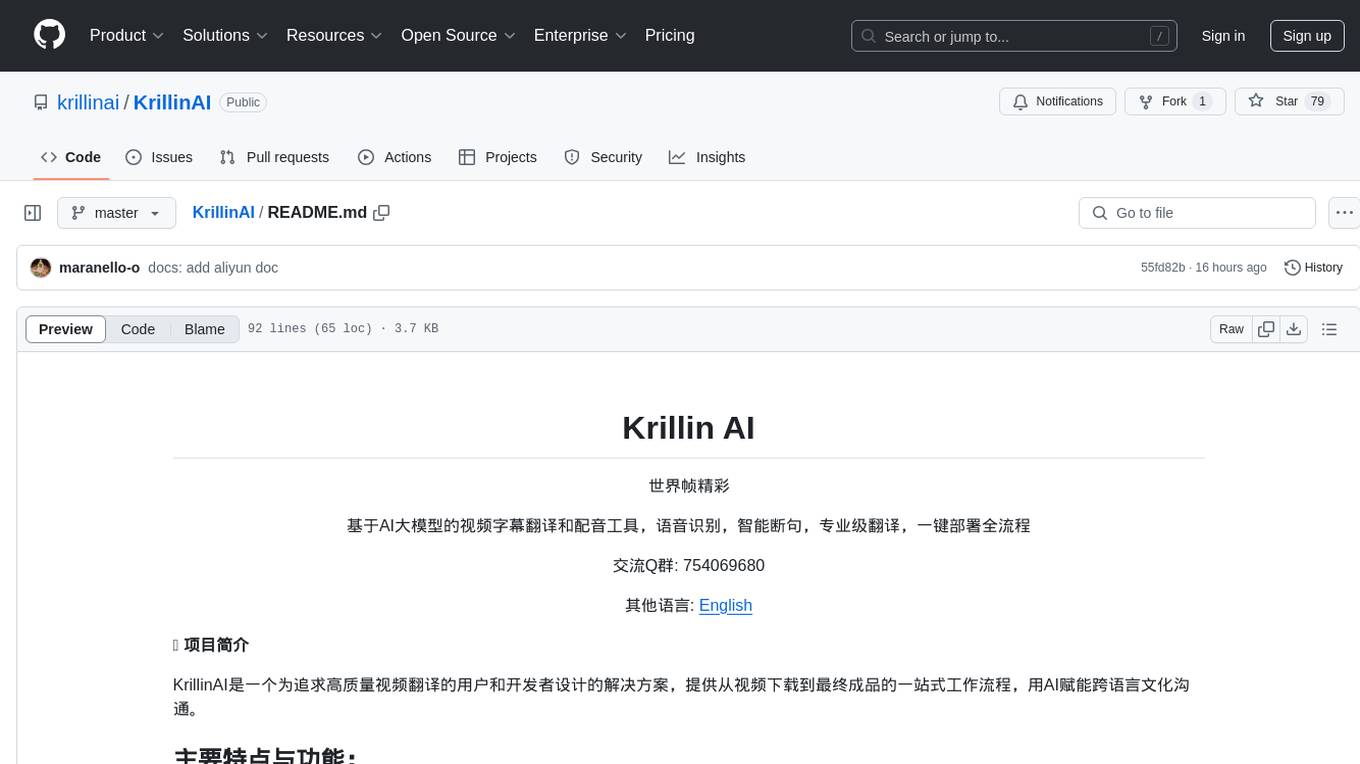
KrillinAI
KrillinAI is a video subtitle translation and dubbing tool based on AI large models, featuring speech recognition, intelligent sentence segmentation, professional translation, and one-click deployment of the entire process. It provides a one-stop workflow from video downloading to the final product, empowering cross-language cultural communication with AI. The tool supports multiple languages for input and translation, integrates features like automatic dependency installation, video downloading from platforms like YouTube and Bilibili, high-speed subtitle recognition, intelligent subtitle segmentation and alignment, custom vocabulary replacement, professional-level translation engine, and diverse external service selection for speech and large model services.
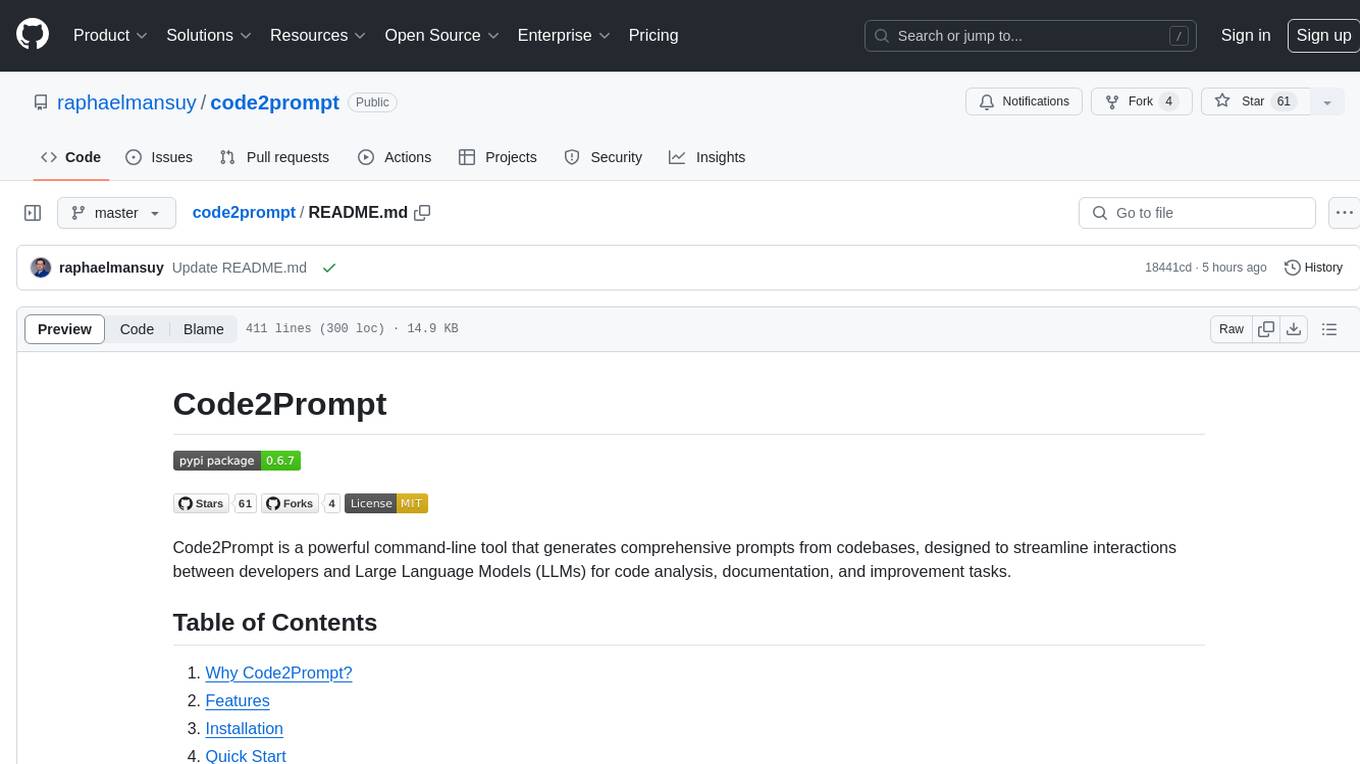
code2prompt
Code2Prompt is a powerful command-line tool that generates comprehensive prompts from codebases, designed to streamline interactions between developers and Large Language Models (LLMs) for code analysis, documentation, and improvement tasks. It bridges the gap between codebases and LLMs by converting projects into AI-friendly prompts, enabling users to leverage AI for various software development tasks. The tool offers features like holistic codebase representation, intelligent source tree generation, customizable prompt templates, smart token management, Gitignore integration, flexible file handling, clipboard-ready output, multiple output options, and enhanced code readability.
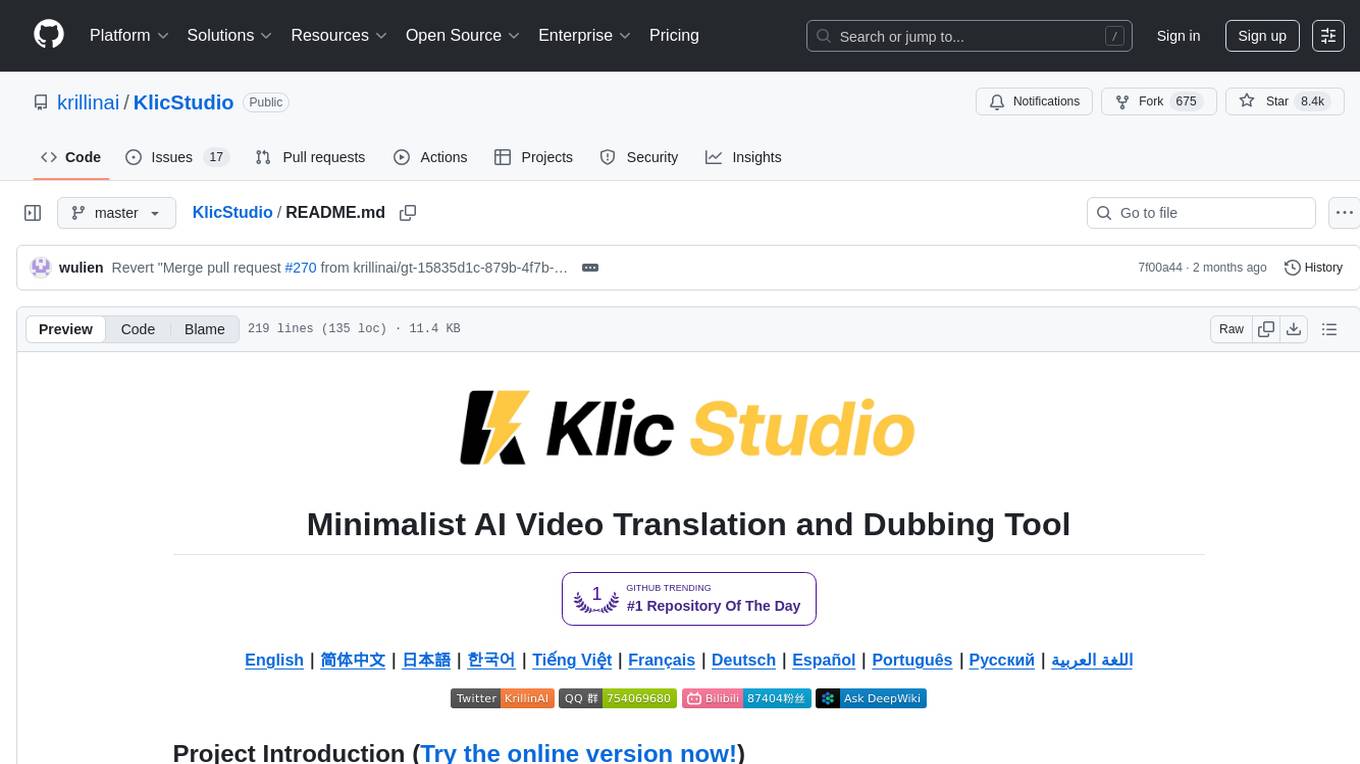
KlicStudio
Klic Studio is a versatile audio and video localization and enhancement solution developed by Krillin AI. This minimalist yet powerful tool integrates video translation, dubbing, and voice cloning, supporting both landscape and portrait formats. With an end-to-end workflow, users can transform raw materials into beautifully ready-to-use cross-platform content with just a few clicks. The tool offers features like video acquisition, accurate speech recognition, intelligent segmentation, terminology replacement, professional translation, voice cloning, video composition, and cross-platform support. It also supports various speech recognition services, large language models, and TTS text-to-speech services. Users can easily deploy the tool using Docker and configure it for different tasks like subtitle translation, large model translation, and optional voice services.
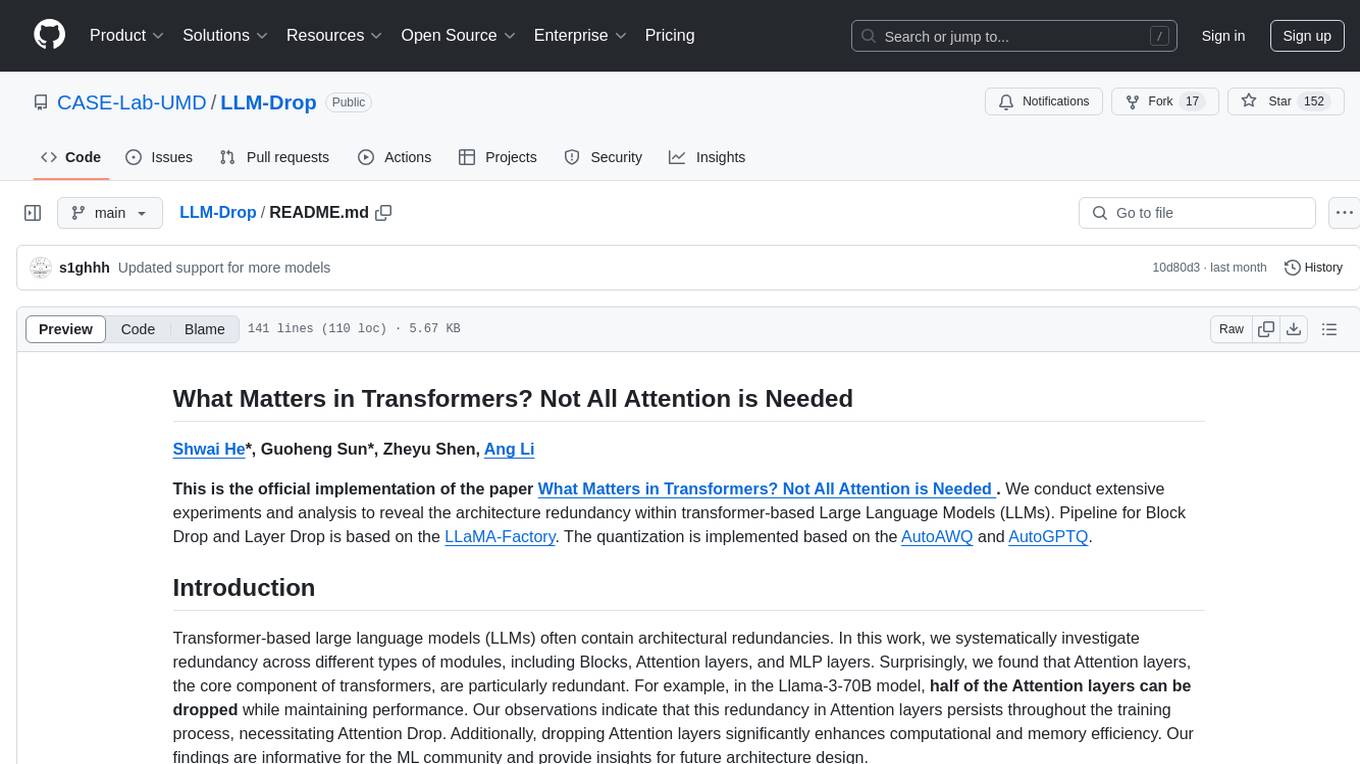
LLM-Drop
LLM-Drop is an official implementation of the paper 'What Matters in Transformers? Not All Attention is Needed'. The tool investigates redundancy in transformer-based Large Language Models (LLMs) by analyzing the architecture of Blocks, Attention layers, and MLP layers. It reveals that dropping certain Attention layers can enhance computational and memory efficiency without compromising performance. The tool provides a pipeline for Block Drop and Layer Drop based on LLaMA-Factory, and implements quantization using AutoAWQ and AutoGPTQ.
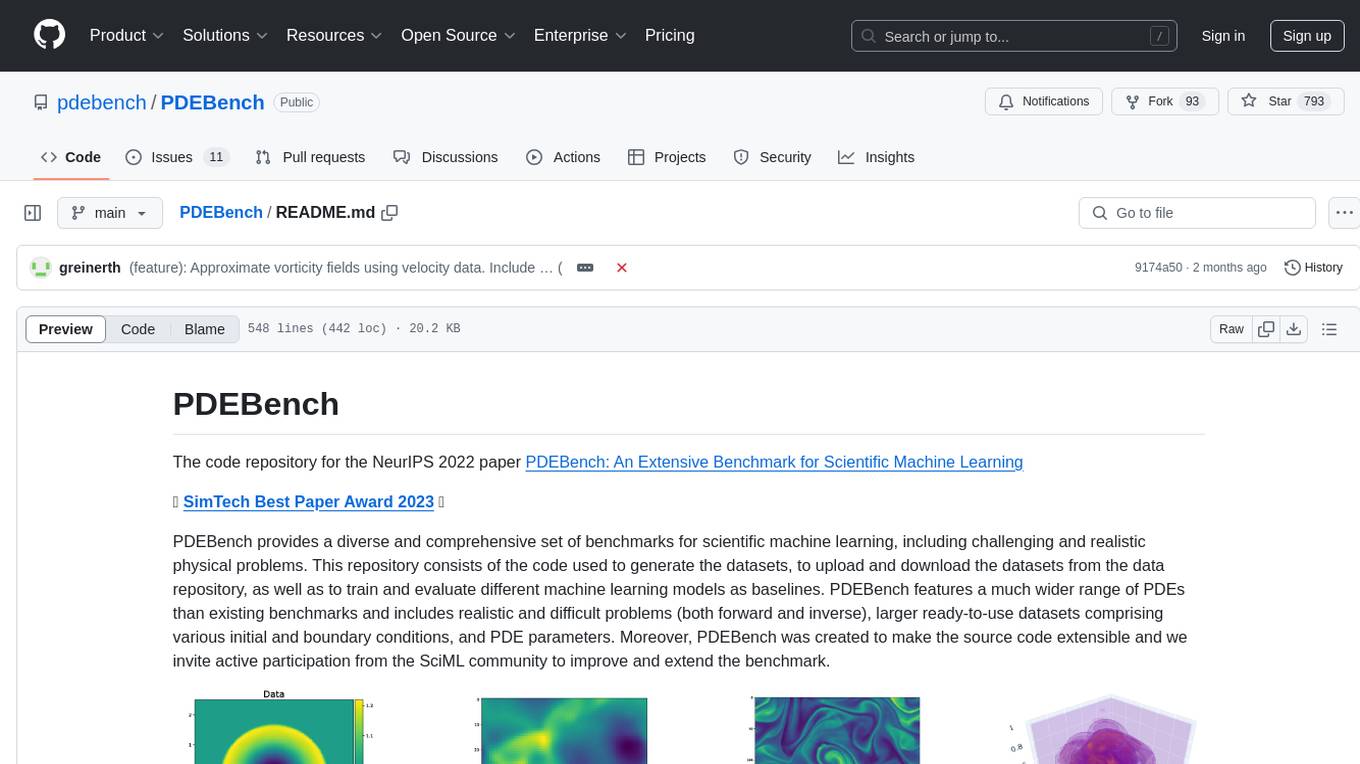
PDEBench
PDEBench provides a diverse and comprehensive set of benchmarks for scientific machine learning, including challenging and realistic physical problems. The repository consists of code for generating datasets, uploading and downloading datasets, training and evaluating machine learning models as baselines. It features a wide range of PDEs, realistic and difficult problems, ready-to-use datasets with various conditions and parameters. PDEBench aims for extensibility and invites participation from the SciML community to improve and extend the benchmark.
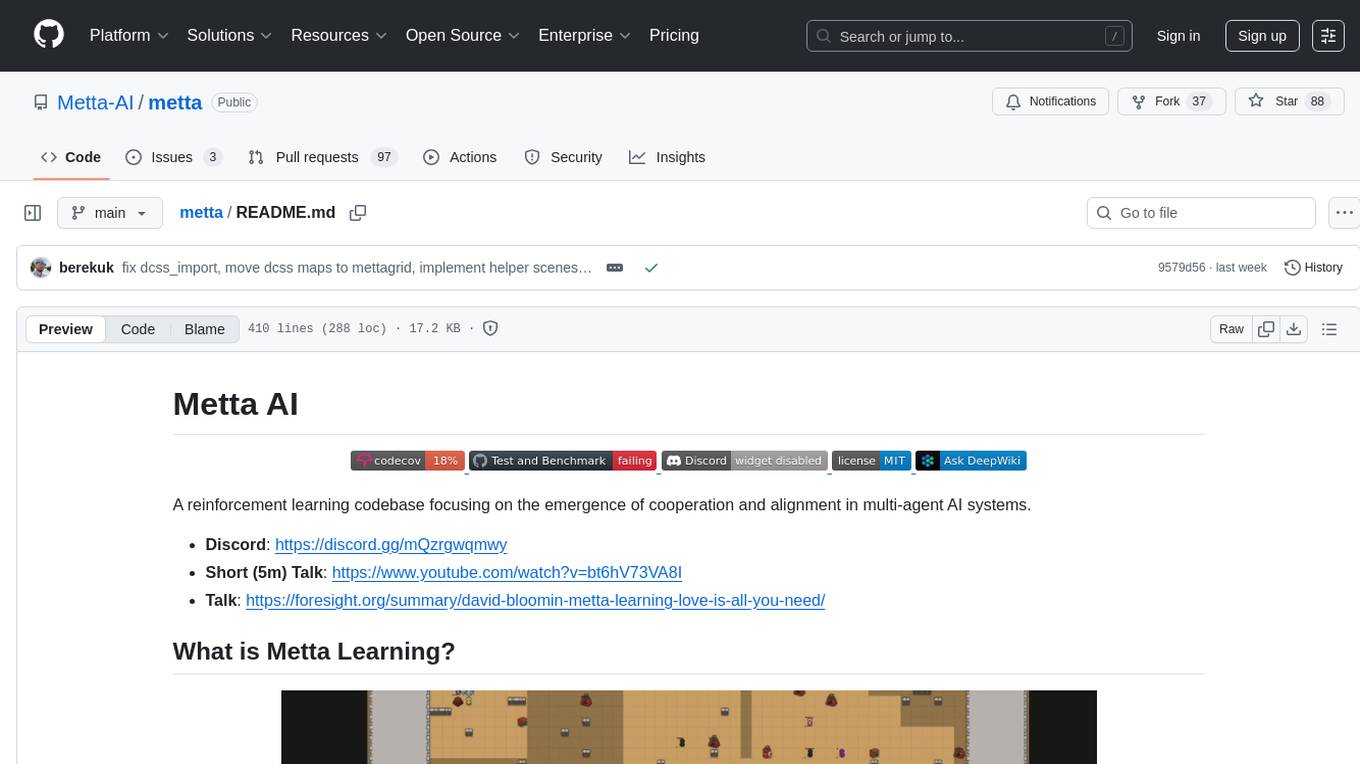
metta
Metta AI is an open-source research project focusing on the emergence of cooperation and alignment in multi-agent AI systems. It explores the impact of social dynamics like kinship and mate selection on learning and cooperative behaviors of AI agents. The project introduces a reward-sharing mechanism mimicking familial bonds and mate selection to observe the evolution of complex social behaviors among AI agents. Metta aims to contribute to the discussion on safe and beneficial AGI by creating an environment where AI agents can develop general intelligence through continuous learning and adaptation.
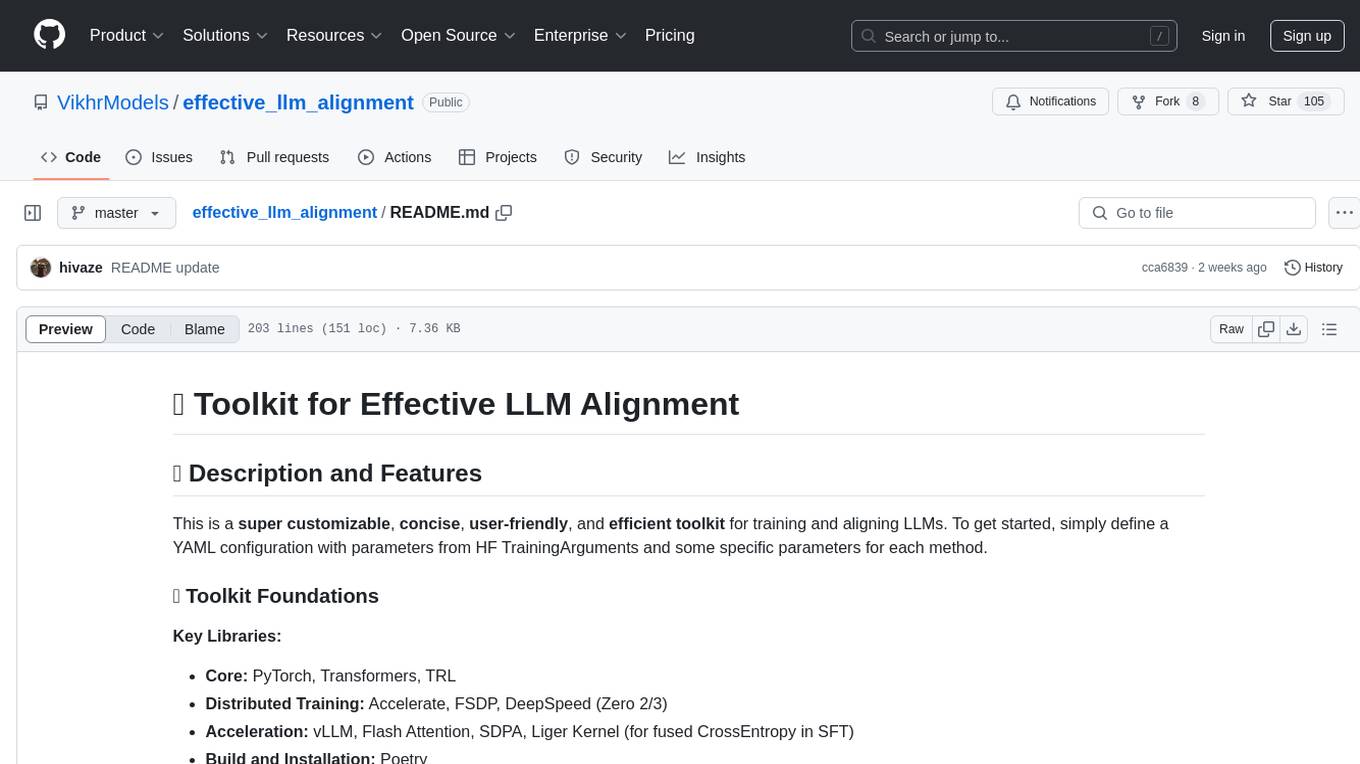
effective_llm_alignment
This is a super customizable, concise, user-friendly, and efficient toolkit for training and aligning LLMs. It provides support for various methods such as SFT, Distillation, DPO, ORPO, CPO, SimPO, SMPO, Non-pair Reward Modeling, Special prompts basket format, Rejection Sampling, Scoring using RM, Effective FAISS Map-Reduce Deduplication, LLM scoring using RM, NER, CLIP, Classification, and STS. The toolkit offers key libraries like PyTorch, Transformers, TRL, Accelerate, FSDP, DeepSpeed, and tools for result logging with wandb or clearml. It allows mixing datasets, generation and logging in wandb/clearml, vLLM batched generation, and aligns models using the SMPO method.
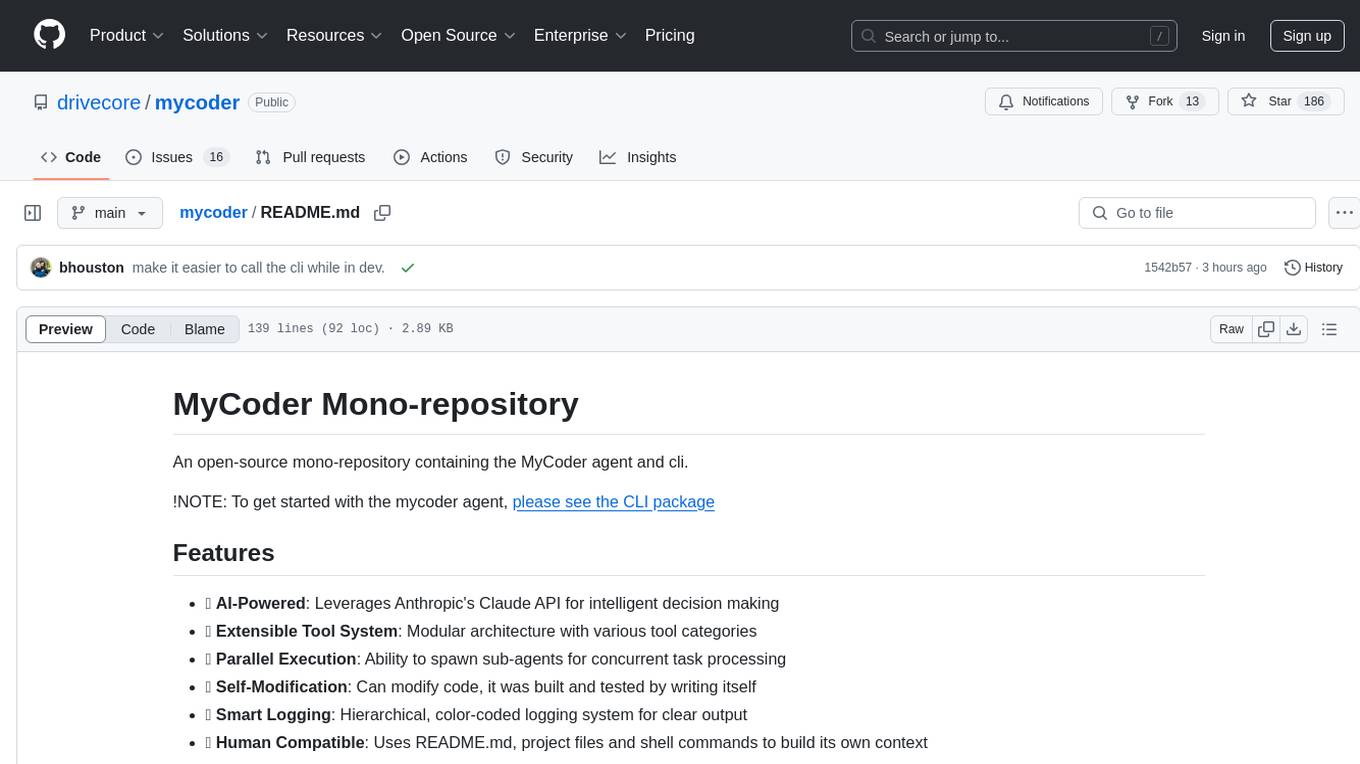
mycoder
An open-source mono-repository containing the MyCoder agent and CLI. It leverages Anthropic's Claude API for intelligent decision making, has a modular architecture with various tool categories, supports parallel execution with sub-agents, can modify code by writing itself, features a smart logging system for clear output, and is human-compatible using README.md, project files, and shell commands to build its own context.
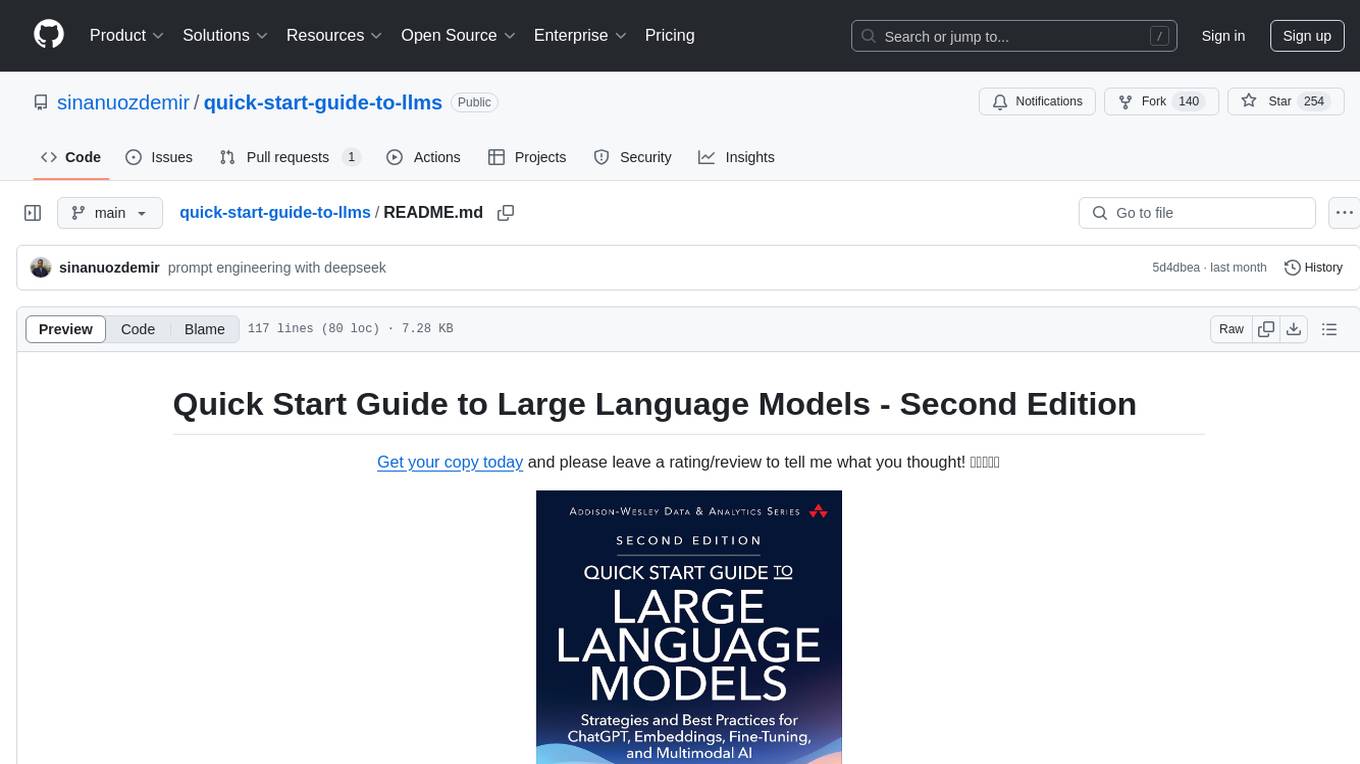
quick-start-guide-to-llms
This GitHub repository serves as the companion to the 'Quick Start Guide to Large Language Models - Second Edition' book. It contains code snippets and notebooks demonstrating various applications and advanced techniques in working with Transformer models and large language models (LLMs). The repository is structured into directories for notebooks, data, and images, with each notebook corresponding to a chapter in the book. Users can explore topics such as semantic search, prompt engineering, model fine-tuning, custom embeddings, advanced LLM usage, moving LLMs into production, and evaluating LLMs. The repository aims to provide practical examples and insights for working with LLMs in different contexts.
For similar tasks

MOOSE
MOOSE 2.0 is a leaner, meaner, and stronger tool for 3D medical image segmentation. It is built on the principles of data-centric AI and offers a wide range of segmentation models for both clinical and preclinical settings. MOOSE 2.0 is also versatile, allowing users to use it as a command-line tool for batch processing or as a library package for individual processing in Python projects. With its improved speed, accuracy, and flexibility, MOOSE 2.0 is the go-to tool for segmentation tasks.
For similar jobs

MOOSE
MOOSE 2.0 is a leaner, meaner, and stronger tool for 3D medical image segmentation. It is built on the principles of data-centric AI and offers a wide range of segmentation models for both clinical and preclinical settings. MOOSE 2.0 is also versatile, allowing users to use it as a command-line tool for batch processing or as a library package for individual processing in Python projects. With its improved speed, accuracy, and flexibility, MOOSE 2.0 is the go-to tool for segmentation tasks.
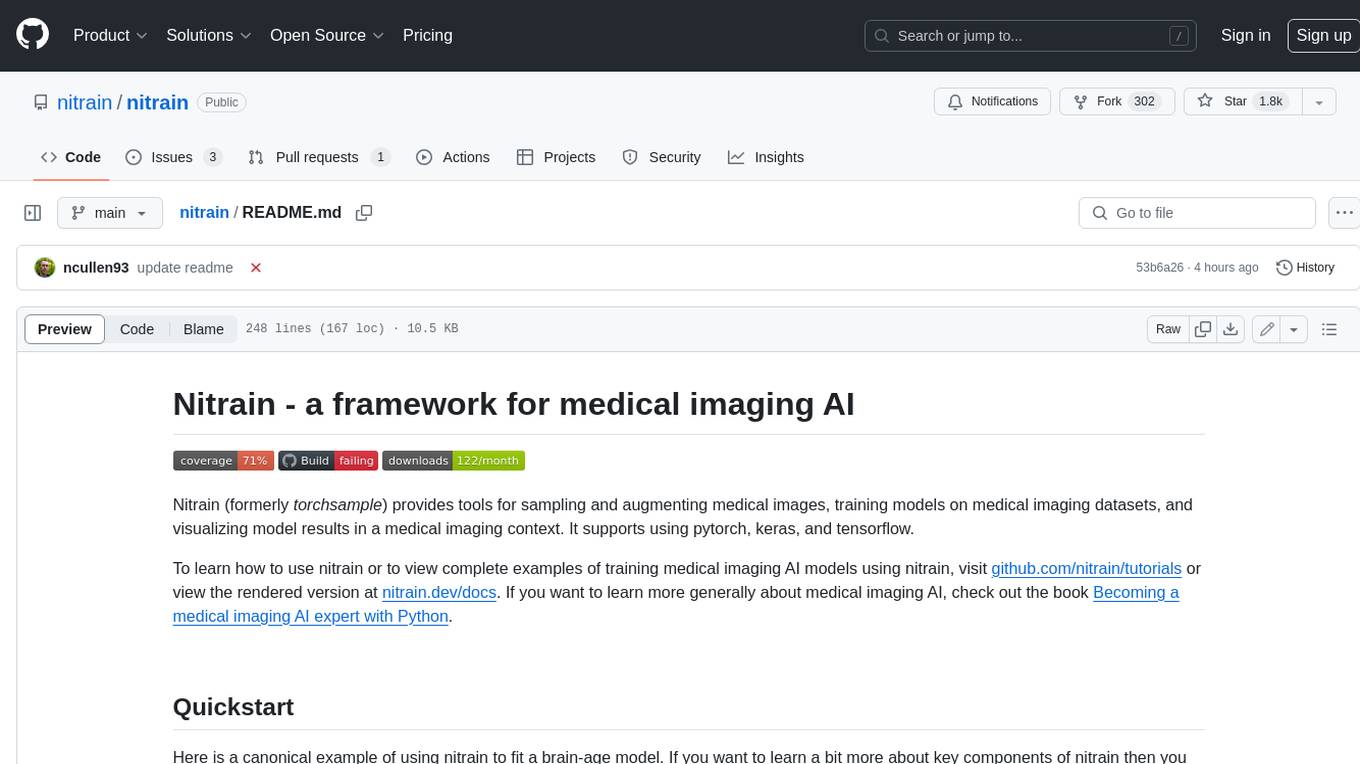
nitrain
Nitrain is a framework for medical imaging AI that provides tools for sampling and augmenting medical images, training models on medical imaging datasets, and visualizing model results in a medical imaging context. It supports using pytorch, keras, and tensorflow.





&color=9400D3&style=flat-square&logo=python)
&color=9400D3&style=flat-square&logo=python)


